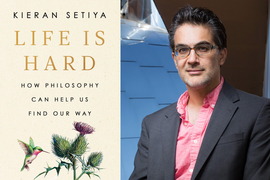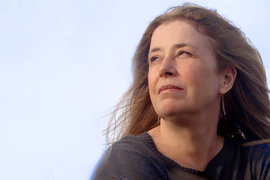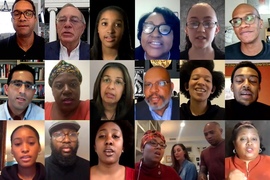Since the invention of the telegraph, humans have been able to communicate across great distances in real-time. Today, we can choose among myriad technologies — radio, telephone, video conference platforms — to connect with colleagues and loved ones in different time zones, countries, and continents. These technologies create a telepresence — a sense of nearness between living beings separated only by space.
“The purpose of telepresence is to connect people who are alive,” says Hiroshi Ishii, the Jerome B. Wiesner Professor of Media Arts and Sciences at the MIT Media Lab, where he directs the Tangible Media research group. “But what about communicating with people who are no longer with us? That is the aim of TeleAbsence, our speculative design project. We attempt to bridge the vast emotional distance caused by bereavement. To create the illusion that we are communicating and interacting with a loved one who has departed. And to discover whether this illusory communication can help soothe our grief.”
Launched in the late 1990s, the Tangible Media research group works to give the virtual world a physical form. The group has invented tangible interface technologies, developed urban planning and simulation tools, and designed dozens of user interface devices that facilitate a merger of real and virtual environments.
The TeleAbsence project, supported, in part, by the Center for Art, Science and Technology (CAST), is one of the group’s most ambitious efforts. In addition to blending the real and virtual worlds, it also probes — and imitates — the way humans process feelings of belonging, love, and loss. Originally inspired by bereavement, the project has evolved, and now addresses other forms of loss and emotional distance.
Dialing up past lives
“My practice has always explored the way objects and environments create identity and preserve memory,” says Danny Pillis, a graduate student in media arts and sciences and affiliate of the Media Lab. “And I’ve always been fascinated by the way experiences imprint themselves into the human mind.”
For the TeleAbsence project, Pillis collaborated with faculty and students at the Berklee College of Music and Xiao Xiao at the De Vinci Innovation Center in Paris to build the AmbientPhoneBooth. A personal immersive media environment, the AmbientPhoneBooth is an actual phone booth where users can connect with places and homes from their past. The user enters the booth, sits down, and dials a number on a rotary phone. A slow crescendo of sounds emerges, a heartbeat that then morphs into the cadence of a train traveling along a track, and then into a soothing lullaby. Designed by Ziaire Trinidad Sherman, the audio soundscape is controlled by the rotary dial.
A beguiling and seamless blend of technologies across time, the AmbientPhoneBooth juxtaposes legacy technologies like rotary phones and locomotives with state-of-the-art virtual reality headsets and computation. “I am particularly interested in artifacts and media that predate and also anticipate the birth of modern computing,” says Pillis. “I want to see how these tangible artifacts can be advanced by contemporary technology. In a sense, it’s about connecting the Industrial Revolution with the digital revolution.”
Inspired, in part, by the Wind Phone in Japan’s Iwate Prefecture — a deactivated phone booth that thousands of people visit each year to “speak” to lost loved ones — the AmbientPhoneBooth is a work in progress. In the future, the user will be able to input family photos, home movies, and highly detailed scans of their childhood homes, and then experience these images as a hyper-real virtual reality recreation. At present, the virtual reality headset recreates the past experiences of a family home in Pittsburgh. “The goal is to create a template for future home media,” Pillis explains. “To provide people with the tools to create interactive virtual memories of a home or place they once inhabited. We all share a common human story, of space and place and identity.”
Words no longer yours
For Kyung Yun Choi, a media arts and sciences graduate student and Media Lab affiliate from Seoul, South Korea, the TeleAbsence project meant probing the relationship between her external and inner self. “Part of my project comes from speaking in English here in the U.S. instead of Korean,” says Choi. “In this new language, the words I spoke didn’t feel like mine. It was as if I’d become a different person, a person I was observing from a distance.”
To recreate that sense of distance — an alienation from self she describes as simply “weird” — Choi created an interactive installation in which an user speaks into a microphone. Those spoken words are relayed to an automated typewriter that translates the speech into Morse code — excluding the words “I” and “you.” The installation simulates the perception of distance and the experience of losing authority over one’s own thoughts. “In the past, people wrote on typewriters, and used Morse code to deliver messages across distance,” she explains. “Now we use speech recognition to send text messages. I wanted to capture that history of technology, to bring back the memories associated with them, and make them shareable.”
Brushstrokes through time
While Choi’s TeleAbsence project aims to help people connect with their inner selves, Cathy Fang’s project was born out of a desire to connect more deeply with her grandparents, who live halfway around the world.
“During my childhood, in Shanghai, I connected with my grandparents through Chinese calligraphy,” says Fang MS ’23, a PhD student in media arts and sciences and Media Lab affiliate. “What resonates with me, for this TeleAbsence project, was the experience of having a connection to a person and having that connection somehow lost or altered because of time and space.”
While Fang does communicate with her grandparents by phone and video — she also visits with them when she returns to China — she misses the intimacy she shared with them through the rich sensory experience of tracing brushstrokes on paper. So she created a digitally-driven, three-dimensional plotter that recreates her grandfather’s brush strokes; the machine drafts elegant Chinese characters in black ink on paper. But it’s not the final product that interests her. “This isn’t a tool to recreate characters,” she explains. “It’s an attempt to draw attention to the person behind the traces: their movements and the pressure of their hand on the brush bearing down on paper that are otherwise ephemeral. Traces that can evoke your shared memories and connections.”
Ishii believes these projects can help ease the sense of loss and distance that all humans experience.
“Our goal is to soothe the pain of ‘Saudade,’” he says, “the hard-to-translate Portuguese word for melancholy and longing. And we will do that through tangible objects, abstract ambient media, and by capturing the shadows that people cast as they move through life. Ultimately, I want to see the hand of Cathy Fang’s grandfather in the place of the plotter, so it seems that he, and not the machine, is drawing the characters. That is when I will be satisfied.”













